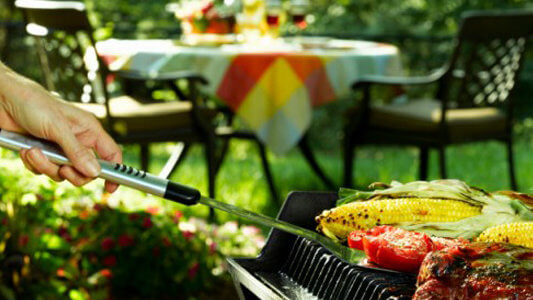
 Print & Share (PDF) 586KB
Print & Share (PDF) 586KB
 Print & Share (PDF) 586KB
Print & Share (PDF) 586KB Imprimir y compartir En Español (Spanish) (PDF) 640KBPicnic and barbecue season offers lots of opportunities for outdoor fun with family and friends. But these warm weather events also present opportunities for foodborne bacteria to thrive. As food heats up in summer temperatures, bacteria multiply rapidly.
Imprimir y compartir En Español (Spanish) (PDF) 640KBPicnic and barbecue season offers lots of opportunities for outdoor fun with family and friends. But these warm weather events also present opportunities for foodborne bacteria to thrive. As food heats up in summer temperatures, bacteria multiply rapidly.
To protect yourself, your family, and friends from foodborne illness during warm-weather months, safe food handling when eating outdoors is critical. Read on for simple food safety guidelines for transporting your food to the picnic site, and preparing and serving it safely once you’ve arrived.
Keep your food safe: from the refrigerator/freezer — all the way to the picnic table.

Food safety begins with proper hand cleaning — including in outdoor settings. Before you begin setting out your picnic feast, make sure hands and surfaces are clean.
Grilling and picnicking often go hand-in-hand. And just as with cooking indoors, there are important guidelines that should be followed to ensure that your grilled food reaches the table safely.

Never reuse a plate or utensils that previously held raw meat, poultry, or seafood for serving — unless they’ve been washed first in hot, soapy water. Otherwise, you can spread bacteria from the raw juices to your cooked or ready-to-eat food. This is particularly important to remember when serving cooked foods from the grill.
 Serving Picnic Food
Serving Picnic FoodKeeping food at proper temperatures — indoor and out — is critical in preventing the growth of foodborne bacteria. The key is to never let your picnic food remain in the “Danger Zone” — between 40 °F and 140 °F — for more than 2 hours, or 1 hour if outdoor temperatures are above 90 °F. This is when bacteria in food can multiply rapidly, and lead to foodborne illness.
Instead, follow these simple rules for keeping cold foods cold and hot foods hot.

Cold perishable food should be kept in the cooler at 40 °F or below until serving time.

Hot food should be kept hot, at or above 140 °F.
Wash hands and surfaces often
Separate raw meats from other foods
Cook to the right temperature
Refrigerate foods promptly
Source: FDA.gov
 Fentanyl Seizures at Border Continue to Spike, Making San Diego a National Epicenter for Fentanyl Trafficking
Fentanyl Seizures at Border Continue to Spike, Making San Diego a National Epicenter for Fentanyl TraffickingFentanyl Seizures at Border Continue to.
 Utah Man Sentenced for Hate Crime Attack of Three Men
Utah Man Sentenced for Hate Crime Attack of Three MenTuesday, August 8, 2023 A.
 Green Energy Company Biden Hosted At White House Files For Bankruptcy
Green Energy Company Biden Hosted At White House Files For BankruptcyAug 7 (Reuters) – Electric-vehicle parts.
 Former ABC News Reporter Who “Debunked” Pizzagate Pleads Guilty of Possessing Child pδrn
Former ABC News Reporter Who “Debunked” Pizzagate Pleads Guilty of Possessing Child pδrnFriday, July 21, 2023 A former.
 Six Harvard Medical School and an Arkansas mortuary Charged With Trafficking In Stolen Human Remains
Six Harvard Medical School and an Arkansas mortuary Charged With Trafficking In Stolen Human RemainsSCRANTON – The United States.
 Over 300 People Facing Federal Charges For Crimes Committed During Nationwide Demonstrations
Over 300 People Facing Federal Charges For Crimes Committed During Nationwide DemonstrationsThe Department of Justice announced that.